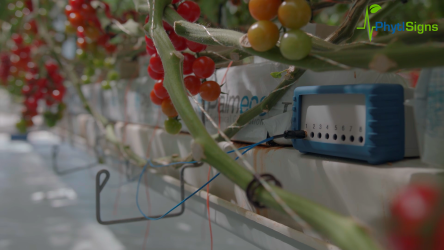All plants uses internal electrical, mechanical, and chemical signaling networks to coordinate growth, reproduction, and defense - and Vivent is the first company in the world to launch a commercial crop health diagnostic system based on plant electrophysiology.
Interpreting electrical signals using machine learning enables the early detection of plant stress, disease, and nutrient deficiencies.
Here is a selection of some common questions on our device, PhytlSigns, and its applications to agriculture:
Q: Can PhytlSigns be used outdoors, for monitoring plants in the field? Can it be used on arable crops?
A: Yes it certainly can, there are of course considerations for outdoor use compared to indoor use, such as the number of sensors per hectare based on environmental conditions. We also need a power source, usually a small solar panel or battery. We have algorithms for several arable crops already.
Q: Are they specific electrical signals according to the stress?
A: Yes absolutely, we can tell the difference between different pests, or abiotic stresses (water, different kinds of nutrients)
Q: How many plants can I monitor at the same time ?
A: Our sensors come with either 2 channels (up to 2 plants) or 8 channels (up to 8 plants)
Q: Can I fit PhytlSigns on mobile units like robots?
A: Not yet, but in the future yes, we need to develop a wireless system for this to work.
Q: Can I detect all stresses with the same sensor?
A: The same sensor collects the information, the algorithm can then differentiate the different stresses.
Q: Can the algorithm differentiate between different stimuli? What happens when stressors are applied at the same time? How do the models single out the deficiencies when multiple stress factors happen simultaneously? Can your model differentiate between a root pathogen infection and drought stress?
A: Yes, the algorithm can differentiate the different stresses/stimuli even when they occur at the same time.
Q: Is there any environmental impact in using the device?
A: There is a positive environmental impact in using the device, therefore the grower should see their use of water, pesticides and fertilizers go down, this will lead to a more sustainable agriculture. The device itself only consumes a very small amount of energy.
Q: How is the electrical potential measured – leaf/stem/flower? Is it uniform across the plant?
A: The electrical potential isn’t uniform across the plant, but we try and find where the best signal is in each species. Most importantly we are interested in how the signal varies over time.
Q: A group of scientists would like to test plant responses to high frequencies of 5G communication technology. Do you think your device would be able to detect and interpret the impact of this radiation on plant vitality?
A: Plants are subject to a wide range of radiofrequencies from the sun so a lot will depend on power levels – Please contact us to discuss further.
Q: Is it possible to detect an electrophysiological response in plants related to changes in non-pathogenic soil microbial communities (i.e. in response to manipulation of beneficial soil bacteria or fungi)?
A: Yes, if the soil borne microbes affect the vitality of the plant then we will see the responses.
Q: Is it possible to predict growth potentials? Can it be used to predict crop timing and quantity?
A: Yes, PhytlSigns can help to predict growth, yield (quantity) as well as the timing of the crop readiness.
Q: What TRL (Technology Readiness Level) have you reached today with PhytlSigns?
A: We are at level 8-9.
Q: How many fruit and vegetables have you got algorithms for so far?
A: We have algorithms for 10 different crops. This covers 20% of the top 25 food crops Worldwide and 20% of the top 25 food crops for Europe (by tons of production per year FAO).
Q: Is the program available for individual farmers? What is the cost for license and setup for two plants?
A: Yes of course, we can provide devices and services to any size of farm. The set-up varies in price depending on the number of channels, the number of algorithms needed, and the location. Please contact us for details.
Q: Is the model constantly improving even after the development phase? Can further experimentations “in the field” contribute to the machine learning ?
A: The model is not constantly improving. It’s important to think about re-training strategies to avoid model drift.
Please feel free to contact us if you have any more questions - we would love to hear from you.

